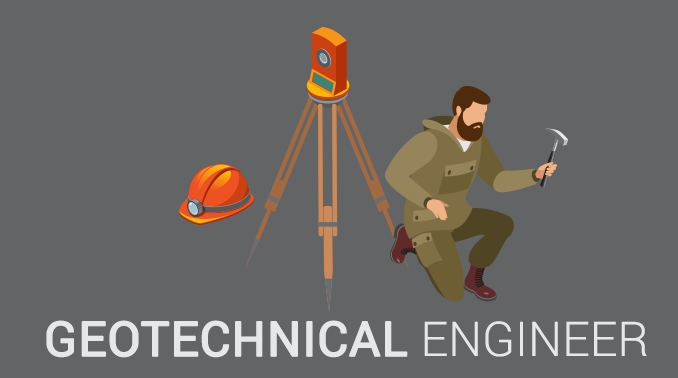See This Report on Geotheta
See This Report on Geotheta
Blog Article
Everything about Geotheta
Table of ContentsSome Known Details About Geotheta See This Report about Geotheta6 Easy Facts About Geotheta DescribedThe Geotheta StatementsSome Ideas on Geotheta You Need To Know

They perform site investigations, gather examples, carry out research laboratory examinations, and evaluate information to review the viability of the ground for building and construction projects - Geo Tech Engineering. Based upon their searchings for, geotechnical designers supply suggestions for structure style, incline security, keeping frameworks, and reduction of geotechnical hazards. They work together with other experts, such as designers, structural engineers, and construction groups, to ensure that geotechnical factors to consider are incorporated into the general task design and execution
By analyzing the habits and residential or commercial properties of dirt and rock, they can identify potential geotechnical dangers such as landslides, soil negotiation, or incline instability. Their knowledge helps avoid failings or crashes that might endanger lives and building. Here are some comprehensive tasks and obligations of a geotechnical engineer: Site Investigation: Geotechnical engineers conduct website investigations to gather information on subsurface problems.
They interpret the data to understand the buildings and actions of the dirt and rock, including their stamina, permeability, compaction attributes, and groundwater conditions. Geotechnical Evaluation and Layout: Geotechnical designers assess the data gathered during site examinations to assess the stability and suitability of the site for building and construction projects. They perform geotechnical estimations and modeling to review aspects such as birthing capacity, negotiation, slope stability, lateral earth pressures, and groundwater flow.
Geotheta Fundamentals Explained
Structure Style: Geotechnical engineers play a crucial duty in creating foundations that can securely sustain the designated structure. They analyze the soil problems and load demands to identify the suitable structure type, such as superficial foundations (e.g., footings), deep structures (e.g (https://soundcloud.com/geotheta)., stacks), or specialized techniques like soil renovation. They take into consideration variables such as negotiation limitations, bearing ability, and soil-structure communication to establish optimal foundation styles
They evaluate construction strategies, display website tasks, and conduct area assessments to confirm that the design referrals are complied with. If unexpected geotechnical concerns develop, they evaluate the situation and supply suggestions for removal or modifications to the design. Danger Analysis and Reduction: Geotechnical engineers examine geotechnical risks and threats connected with the project website, such as landslides, liquefaction, or soil disintegration.

Collaboration and Interaction: Geotechnical designers work very closely with other specialists associated with a project, such as engineers, structural designers, and building teams. Efficient communication and cooperation are important to integrate geotechnical considerations right into the overall task style and construction procedure. Geotechnical engineers give technical competence, solution inquiries, and make certain that geotechnical demands are fulfilled.
The Basic Principles Of Geotheta
Here are some types of geotechnical engineers: Structure Designer: Foundation engineers focus on creating and evaluating structures for frameworks. They analyze the dirt conditions, load requirements, and site features to identify one of the most proper foundation type and design, such as shallow foundations, deep foundations, or specialized techniques like pile foundations.
They assess the elements influencing slope stability, such as soil residential or commercial properties, groundwater conditions, and slope geometry, and develop techniques to stop incline failings and minimize dangers. Quake Engineer: Quake engineers focus on assessing and making frameworks to hold up against seismic pressures. They analyze the seismic threat of a website, review dirt liquefaction possibility, and establish seismic style criteria to ensure the safety and resilience of frameworks during earthquakes.
They perform field screening, accumulate samples, and evaluate the collected information to define the soil homes, geologic formations, and groundwater problems at a site. Geotechnical Instrumentation Engineer: Geotechnical instrumentation designers concentrate on surveillance and determining the behavior of dirt, rock, and frameworks. They install and keep instrumentation systems that keep an eye on elements such as soil settlement, groundwater degrees, incline movements, and structural displacements to evaluate performance and offer very early cautions of prospective concerns.
See This Report on Geotheta
They conduct tests such as triaxial examinations, loan consolidation tests, direct shear examinations, and permeability examinations to collect data for geotechnical analysis and layout. Geosynthetics Engineer: Geosynthetics engineers concentrate on the design and application of geosynthetic materials, such as geotextiles, geogrids, and geomembranes. They utilize these products to improve dirt security, reinforce slopes, give drainage options, and control disintegration.
They tend to be investigative individuals, which indicates they're intellectual, reflective, and curious. They are interested, systematic, rational, analytical, and rational. A few of them are additionally social, meaning they're kind, generous, participating, individual, caring, helpful, compassionate, skillful, and pleasant. Does this sound like you? Take our free profession test to learn if geotechnical designer is just one of your leading job suits.
In the workplace setting, geotechnical engineers make use of specialized software devices to do computations, produce designs, and assess information. They prepare records, review task specifications, connect with clients and team members, and coordinate job activities. The workplace setup gives a conducive atmosphere for research study, evaluation, and collaboration with various other experts included in the job.
The smart Trick of Geotheta That Nobody is Talking About
They regularly check out task websites to carry out website investigations, examine geotechnical conditions, and collect data for analysis. These check outs include taking a trip to different areas, occasionally in remote or difficult terrains. Geotechnical engineers may execute soil tasting, conduct tests, and screen building activities to make certain that the geotechnical elements of the task are being applied appropriately.
Geotechnical designers additionally work in specialized geotechnical labs. Geotechnical lab designers function you could try this out thoroughly in these settings, taking care of screening devices, operating tools, and videotaping information.
Report this page